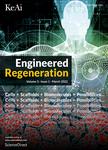Driving modes and characteristics of biomedical micro-robots
作者机构:The Higher Educational Key Laboratory for Biomedical Engineering of Fujian ProvinceDepartment of BiomaterialsResearch Center of Biomedical Engineering of XiamenCollege of MaterialsXiamen University422 Siming Nan RoadXiamen 361005People’s Republic of China State Key Laboratory of Physical Chemistry of Solid SurfacesCollege of Chemistry and Chemical EngineeringXiamen UniversityXiamen 361005People’s Republic of China
出 版 物:《Engineered Regeneration》 (再生工程(英文))
年 卷 期:2023年第4卷第4期
页 面:411-426页
核心收录:
学科分类:080202[工学-机械电子工程] 08[工学] 0804[工学-仪器科学与技术] 0802[工学-机械工程]
基 金:supported by the National Natural Science Foundation of China(Grants No.U1904206,32271469,52273305) Natural Science Foundation of Xiamen(Grants No.3502Z20227010) Fundamental Research Funds for the Central Universities(Grants No.20720230037)
主 题:Micro-robots Biomedical Actuation modules Driving mechanism Smart materials
摘 要:Micro-robots(MRs)are miniature machines with dimensions smaller than 1 mm and have semior fully-autonomous capabilities,including sensing,decision-making,and performing *** MRs have garnered significant attention in the precision medicine and personalized treatment field due to their ability to navigate narrow areas of the human body with non-desirable fluid ***,MRs are actuated by a mechanism that generates propulsive force through the interaction between MRs’actuation modules and external energy sources in a specific *** driving mechanism enables the precise execution of medical treatment such as targeted drug delivery and minimally invasive ***,MRs currently encounter certain challenges in clinical practice,including reliance on external energy sources,short lifespan,and difficulties in degradation or recovery within the human *** article aims to review the common components and characteristics of driving mechanism for MRs’actuation modules,propose possible solutions to address current clinical challenges,and ultimately,explore the desirable structural and functional composition for the future development of *** these efforts,this review hopes to provide guidance for the future development of MRs in the field of precision medicine.



